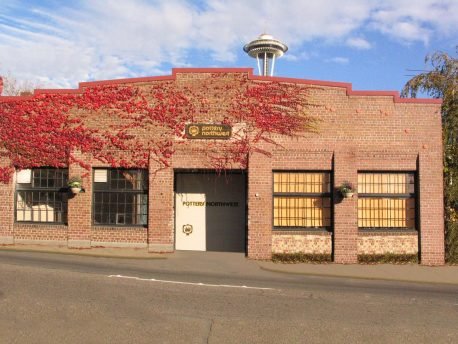Two new landmarks: Bressi Garage and the Coliseum
Introduction
Visiting the south of France on a lazy day in August, I rode my bike past the Tarascon Castle on my way to the European festival of basket weaving. Occupied for the first time in 1435, the castle is one of the best preserved in Europe. In 1840, it was among the first buildings in France to be designated a landmark. In 177 years of landmark protection, only its use by the German army during WWII ever put it at risk of demolition. In fact, precision bombing of the bridges on the Rhone River by American pilots on June 12, 1944, purposefully dodged French landmarks like this one. Now, thanks to the recent landmark designation of the Bressi Garage and the Seattle Coliseum, they will share a long life with the castle at Tarascon.
Bressi Garage
Known to us as Pottery Northwest, this wonderful survivor of Queen Anne’s early automobile age is now protected. The Landmarks Preservation Board identified both the exterior and the truss system supporting the roof, effectively an interior feature, as protected elements. The nomination prepared by Artifacts, a Tacoma preservation firm, did not dwell on the significance of Pottery Northwest tenancy. It also minimalized the importance of the successful suit filed by community activists at Sacred Heart Church, which lies between Bressi and the Century 21 World’s Fair site, which stopped the Fair’s ‘taking’ of all the land from Second to First Avenues for the 1962 event.
As we often do, the Queen Anne Historical Society wrote a letter regarding this nomination. In this case, we supported the designation of the building, picking out in this case neglected or understated aspects of the building’s history. In our letter, we wrote:
"The nomination reportably describes the fundamental integrity of the Bressi Garage and its ability to convey its significance.
The building meets landmark criteria A, C, D and F.*
While that may seem like a lot for a simple garage, the building is nearly the last soldier standing when it comes to telling the automotive history of Lower Queen Anne (Uptown).
Criterion A: Replacing the function of stables and following the burst of automobiles on the national scene, storage garages allowed people without adequate on-site facilities to own cars. These garages, therefore, contributed to the transformation of the city in the automobile age.
The nomination report omitted the cultural significance of the Bressi Garage related to its association with Pottery Northwest, but this use clearly meets criterion C.
Criterion D: The simple structure manifests prevalent patterns of vernacular industrial/commercial of the 1920s.
There is no question that the Bressi Garage meets criterion F as one of the major historic markers of First Avenue North and the Lower Queen Anne neighborhood.
The Landmarks Preservation Board didn’t quite follow our recommendations for such a broad sweeping designation. They selected only criteria C. and D.; but hey, it only takes one to designate.
The Coliseum
The Washington State Coliseum comes very tardy to the list of Seattle landmarks. Once a cash cow, the city didn’t want landmark designation to prevent alterations or updates. Now the building is so old that proposals for major changes would have triggered an automatic review by the Landmarks Preservation board. Also, with one of the strongest landmark preservation ordinances in the nation, it seemed odd that the city was gaming its own laws. In any case, the Society wrote a letter endorsing speedy action on the Coliseum nomination and designation.
The Queen Anne Historical Society is delighted Seattle Center has nominated the entire Thiry Ensemble including the Century 21 Coliseum as a Seattle landmark. There is no question that the building, meets all of the criteria for designation as prescribed in the City of Seattle’s landmark ordinance.
We believe that the alterations to the building made in 1995 respected the formal integrity of the Coliseum. The iconic roof and the glass curtain wall’s unique fenestration pattern above the lower 1995 level, along with the four sets of massive concrete abutments that support the roof and other structural elements, are easily understood and read just as they did at in 1962. The nomination notes, “On the interior, the most open volume features roof trusses and roof decking,” and those features are also easily understood today.
In our letter, we indicated our worry that the Landmarks Preservation Board would not see how the Coliseum met Criteria B and E.
We have no doubt the Coliseum meets Criteria E, “It is an outstanding work of a designer or builder.” Paul Thiry, the architect, Peter Hostmark, the structural engineer, and the Howard S. Wright Construction Company all meet that standard.
The Queen Anne Historical Society stresses, however, that the building also meets Criteria B: “It is associated in a significant way with the life of a person important in the history of the city, state, or nation.” Paul Thiry’s appointment in 1962 by President John F. Kennedy to the National Capitol Planning Commission, and his subsequent selection by Jacqueline Kennedy as a member of the Kennedy Library Design Advisory Committee, witness that by the time the Century 21 World’s Fair opened, Thiry was recognized as a person with national importance reaching well beyond our city and state.
The Society is thrilled that the Landmarks Preservation Board and designated the Century 21 Coliseum, with the Space Needle and the Science Center, as one of very few buildings in the city’s history to meet all the criteria of the Landmark Ordinance.
So now 180 years after its designation, these two Lower Queen Anne icons join the Tarascon Castle as buildings which are protected forever from demolition and significant change.




